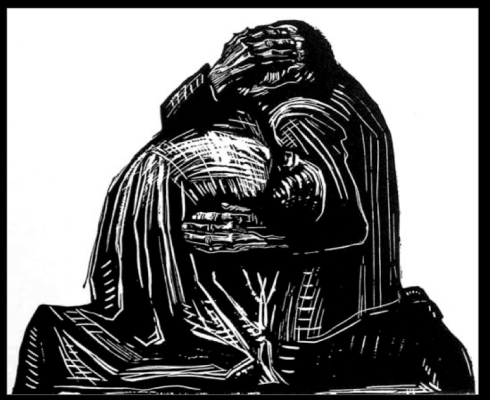
“To the victims of war and tyranny”
The Neue Wache (New Guard House) on Berlin’s Unter den Linden contains the Central Memorial of the Federal Republic of Germany for the Victims of War and Tyranny. It’s a large version of Kathe Kollwitz’s sculpture titled ‘Mother with her Dead Son’. The sculpture is directly under the oculus, and so is exposed to the rain, snow and cold of the Berlin climate, symbolizing the suffering of civilians during World War II.
A special thanks to my friend, Christa Waegemann, for taking this photograph. The white rose Christa placed in front of the sculpture for me, is in memory of Peter Kollwitz (who died in Belgium in 1914 and his nephew and Kathe’s grandson, Peter, who was killed on the Russian Front in 1942), Hans and Sophie Scholl, Anton von Webern, Christa’s 21 year old uncle, whose plane was shot down during WWII, and to all the other resisters and/or victims of Fascism and Militarism.

At the end of 1908 Käthe Kollwitz’ older son Hans had contracted diphtheria and died soon after. Kollwitz became obsessed by this event and produced a series of drawings and echoing groom the years 1910/11. The self-portrait-like features of the etching leave no doubt that it refers to Kollwitz, however the boy is much younger than Hans. “. . . mother and child rest here cheek by cheek. The mother encloses her son in a firm embrace and holds his left hand. Against this woman, Death with his awkward, thin bony arm seems by no means the clear victor. . .”
“The Parents” aka “The Grieving Parents” 1923 woodcut
A self-portrait of Kathe Kollwitz and her husband crushed with grief at the loss of their son.
Käthe Kollwitz, “The Outbreak” aka “Charge 1902-03
etching, drypoint, aquatint and softground
Sheet #5 from the “Peasant’s War” series
In a letter of 1902, Kollwitz wrote: “I consider this Peasants’ War print to be my best work and I am rather happy about it.” Otto Nagel, Kollwitz’s friend, cataloguer, and biographer, felt that “Revolt “was “the most powerful print in the whole series” and added “This is indeed a Revolt; it explodes off the page as the peasants surge forth, there is an unmistakeable determination to fight in their haggard faces. The woman in the foreground raises her arms to give the signal. Kathe once told me that she had portrayed herself in this woman. She wanted the signal to attack to come from her.”
LINKS
http://www.kollwitz.de/en/default.aspx
http://art-kathekollwitz.blogspot.com/
http://tanzafari.deviantart.com/gallery/34309884




